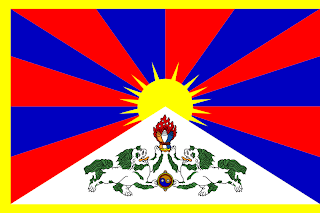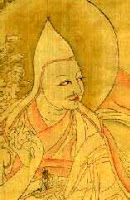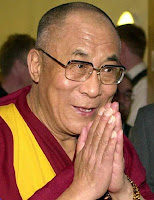Sunday Deposed Monarch Blogging: Dalai Lama
 Tibet’s existence as an independent state is shrouded in controversy. Various empires controlled parts of the Tibetan plateau from the sixth century onward, around the time that Buddhism spread to the area. Much of the territory of modern Tibet was unified in the 17th century under Lobsang Gyatso, fifth reincarnation of the Dalai Lama. The Dalai Lama are said to be the reincarnation of Avalokitesvara, the bodhisattva of compassion. The first Dalai Lama was Gendun Drup, a major Tibetan Buddhist scholar in the fifteenth century. From that time on, a new Dalai Lama was selected by monastic authorities several years after the death of the previous incumbent. Lobsang Gyatso was the first to exercise effective temporal power, and met with the Shunzhi Emperor of the Qing Dynasty on a diplomatic mission in 1652.
Tibet’s existence as an independent state is shrouded in controversy. Various empires controlled parts of the Tibetan plateau from the sixth century onward, around the time that Buddhism spread to the area. Much of the territory of modern Tibet was unified in the 17th century under Lobsang Gyatso, fifth reincarnation of the Dalai Lama. The Dalai Lama are said to be the reincarnation of Avalokitesvara, the bodhisattva of compassion. The first Dalai Lama was Gendun Drup, a major Tibetan Buddhist scholar in the fifteenth century. From that time on, a new Dalai Lama was selected by monastic authorities several years after the death of the previous incumbent. Lobsang Gyatso was the first to exercise effective temporal power, and met with the Shunzhi Emperor of the Qing Dynasty on a diplomatic mission in 1652.
 Chinese influence over Tibet extended greatly in the 18th century, both because of the general growth of Qing power, and because of Tibetan weakness. A Chinese military expedition in 1720 helped install the seventh Dalai Lama in power, and Chinese bureaucrats began to operate in support of the Dalai Lama shortly thereafter. Another Chinese military expedition helped settle a succession crisis in 1750, and Qing military power helped Tibet win a war against Bhutan in the late 18th century. In the 19th century the Qing waned, and Chinese military control over Tibet slipped. Chinese influence was substantially replaced by British, as the latter sought advantage in the “Great Game” against Russia.
Chinese influence over Tibet extended greatly in the 18th century, both because of the general growth of Qing power, and because of Tibetan weakness. A Chinese military expedition in 1720 helped install the seventh Dalai Lama in power, and Chinese bureaucrats began to operate in support of the Dalai Lama shortly thereafter. Another Chinese military expedition helped settle a succession crisis in 1750, and Qing military power helped Tibet win a war against Bhutan in the late 18th century. In the 19th century the Qing waned, and Chinese military control over Tibet slipped. Chinese influence was substantially replaced by British, as the latter sought advantage in the “Great Game” against Russia.
China never renounced its claim to Tibet, even after the fall of the Qing Dynasty or during the warlords period. However, effective Chinese control of Tibet ceased altogether in the early 20th century. Tibetan independence claims, however, were normally not seriously entertained by foreign powers. In 1949 the Chinese Civil War ended in victory for the Communists. Shortly thereafter, the People’s Republic of China began to reassert Chinese claims to control of Tibet. The PLA entered Tibet in 1950 and quickly took Lhasa, easily destroying Tibetan conventional resistance. With support from India and the CIA, Tibetan guerrillas fought the PLA for nine years. The PLA counter-insurgency campaign was successful, however, and substantially destroyed Tibetan resistance by 1959.
 Tenzin Gyatso was recognized as the 14th Dalai Lama in 1939, at the age of four. In 1950, he was accorded temporal rulership of Tibet. For eight years, Tenzin Gyatso remained in Tibet and attempted to work with Chinese authorities. As the final uprising was crushed in 1959, however, the Dalai Lama fled to India. The 14th Dalai Lama established a government-in-exile in India, and since 1959 has acted as an ambassador for Tibetan independence. The Dalai Lama has become an international celebrity, visiting dozens of countries and earning a hit piece by Christopher Hitchens.
Tenzin Gyatso was recognized as the 14th Dalai Lama in 1939, at the age of four. In 1950, he was accorded temporal rulership of Tibet. For eight years, Tenzin Gyatso remained in Tibet and attempted to work with Chinese authorities. As the final uprising was crushed in 1959, however, the Dalai Lama fled to India. The 14th Dalai Lama established a government-in-exile in India, and since 1959 has acted as an ambassador for Tibetan independence. The Dalai Lama has become an international celebrity, visiting dozens of countries and earning a hit piece by Christopher Hitchens.
Prospects for a return to the throne are uncertain. The current Dalai Lama has stated that he will not be reincarnated in territory controlled by the PRC, and has threatened to forego reincarnation altogether. This would end the monarchical line. Tenzin Gyatson has also made mixed statements regarding the resumption of temporal power in Tibet. The proposed Tibetan constitution that the Dalai Lama has advocated vests sovereignty in the people, and allows for parliamentary abolition of the monarchy. The prospects for Tibetan independence seem fairly grim, in no small part because of Chinese efforts to transform the demographics of the region. However, some potential for compromise between the PRC and the current Dalai Lama exist, meaning that a return to the throne of an autonomous but not independent Tibet is not out of the question. It is also possible that the PRC may put forward it’s own Dalai Lama candidate upon Tenzin Gyatson’s death; it is unknown how the PRC will reconcile this candidate with the claims made by the current Dalai Lama.
Trivia: The political party of of one of the pretenders to which throne won less than two tenths of a percent of the vote in 2005 elections?


